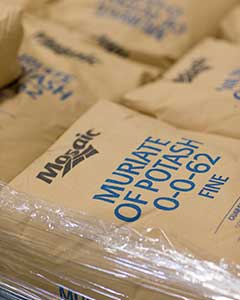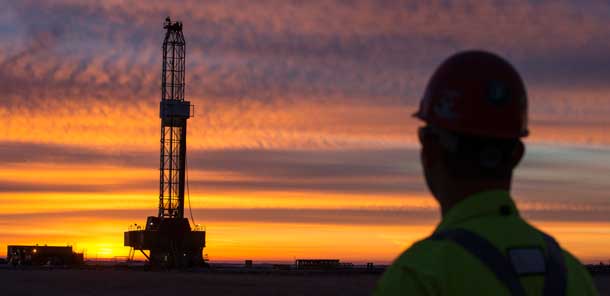Trust is a critical element in any relationship. Without it, the relationship will lack stability and limit success, even in the mining world.
t the Mosaic Company’s Belle Plaine potash facility, a team of engineers and geologists, operators and drillers work in unison and rely on each other’s experiences and expertise in an effort to produce a world-class white potash product that is used as fertilizer for growing healthy plants and in industrial settings.
“We know that we can’t operate in silos because not one person has all of the information he or she needs to run a successful operation,” explained Sheldon Rinas, P.Eng., senior mine manager at Mosaic’s Belle Plaine site.
“We rely on our operators to operate the mining area and refinery. We rely on the loggers to give us information so we can effectively mine our caverns. We rely on drilling rigs and other specialty pieces of process equipment,” says Rinas.
“Engineers and geologists have to rely on each other because one person’s decision affects another person’s area. Everything we do here is interconnected. You have to have really great relationships and collectively work as a team. That is what makes us successful.”
The Belle Plaine site is unique in that it was the first potash solution mine in the world and today remains the largest potash solution mine globally.
Potash is extracted from underground deposits using either conventional mining machines or solution mining, depending on the depth of the resource (in addition to other factors). To mine at depths greater than 1,200 metres, it is safer and more economical to solution mine.
In this technique, warm water is pumped down wells into the potash formation. The potash is dissolved deep underground and the resulting solution is pumped to the plant on the surface where the potash is removed.
Large amounts of water are removed from the solution using evaporators. As the water evaporates, the salt crystallizes first before the potash. Once the salt has crystallized, the remaining potash rich solution goes though the process of crystallizing the potash mineral sylvite.
Another method of recovering the potash is through cooling ponds. The warm brine solution flows into outdoor ponds. As the solution cools, potash crystallizes and sinks to the pond floor. A dredge then is used to collect the crystals and pump them in a slurry to the plant where it will be separated.
“With a solution mine, we don’t have opportunity to visually inspect the mined area,” said Monica Tochor, P.Geo., senior production geologist with The Mosaic Company. “We make decisions using different data and engineering experience. We rely on each other’s expertise to make good business decisions. It’s certainly different than other geological work I have done, but I thrive in the collaborative environment.”
As is the case with most processes, a plan needs to be put in place before any action can occur. Engineers are responsible for developing the mining plan and project management. They’ll collaborate with Tochor and other geologists to determine optimum drilling locations and where best to maximize the resources in the most efficient way.
That collaboration is key because if minerals are missed, depending on what the geology looks like, they may be left irrecoverable. Both Rinas and Tochor said it’s important to plan drilling patterns efficiently the first time, which requires constant communications between the two disciplines.
“If engineers and geologists aren’t working together, there are increased risks of setbacks during drilling, challenges developing caverns, and the potential for decreased yields from the geological resource,” Rinas said.
“The collaboration that does or does not happen between us (engineers and geologists) in the first step affects everything downstream and affects the rest of the team as well as the overall operation. Eventually our product volume or quality could be impacted. You may not realize how far-reaching some of those decisions can be if you’re not working together.”
“We also have to make sure we consult with our geology department and obtain feedback from our team to understand what is possible for the service rig. You don’t want to drill a well that the service rig can’t maintain.”
As part of the planning stages, geologists identify what is mineable. They’ll look at what information is there to continually refine their understanding of the ore bodies and ensure they have the best game plan for responsibly extracting that resource in an economical way.
Geologists spend a lot of time revisiting historical data, refining their interpretation of new data and putting that back to the mine area for planning. They’ll keep in touch with the team in the mine area and the data collection group to make sure everyone has the most recent information.
Teaching Opportunity
There’s also a teaching opportunity involved. Geologists utilize the core samples as part of the training materials so engineers can look at rock samples that were collected and see the geology.
“This is an opportunity to see the quality of the rocks so they can understand how they deploy their engineering strategies to recover the ore,” Tochor said.
In a conventional mine, engineers will actually get to see what they are mining. With solution mining, they only see the product.
The inability to see the rocks beforehand and what is being mined is one of the major challenges in solution mining. That’s where both geologists and engineers will lean on the advancements in technologies.
 “We’re sending down fluids, but we don’t really see the process. Remote sensing is a big part of what we do,” Tochor said. “That’s where innovation and how we use the new science and new technology all feed back into our efficiencies. In an underground mine, you have information immediately. At Mosaic’s Belle Plaine facility, there is a lot of interpretive information from different data collected.”
“We’re sending down fluids, but we don’t really see the process. Remote sensing is a big part of what we do,” Tochor said. “That’s where innovation and how we use the new science and new technology all feed back into our efficiencies. In an underground mine, you have information immediately. At Mosaic’s Belle Plaine facility, there is a lot of interpretive information from different data collected.”
Rinas agreed.
“When you’re first to develop something, you can have all of the best-laid plans. But when you actually get to executing that’s when you find out whether you were right and what’s actually going to happen versus what you thought was going to happen,” he said. “We have learned a lot through trial and error. We have also been relying a lot more on the technology, much of which has been developed ourselves.”
It’s only after the process has been completed do both engineers and geologists have the opportunity to understand the impacts of their work.
Geologists can analyze any problems that happen in the mining area or during drilling. Tochor said she is able to categorize those issues and look for patterns and predictabilities so they can anticipate similar situations before they’re encountered again.
Engineers also review their work to learn where efficiencies can be added or processes modified. For example, analyzing equipment maintenance data, refinery operational data or experiences in particular drilling locations.
All information collected is analyzed and shared with other disciplines. It’s just another example of the collaboration of teams that takes place at Mosaic’s Belle Plaine solution facility.
